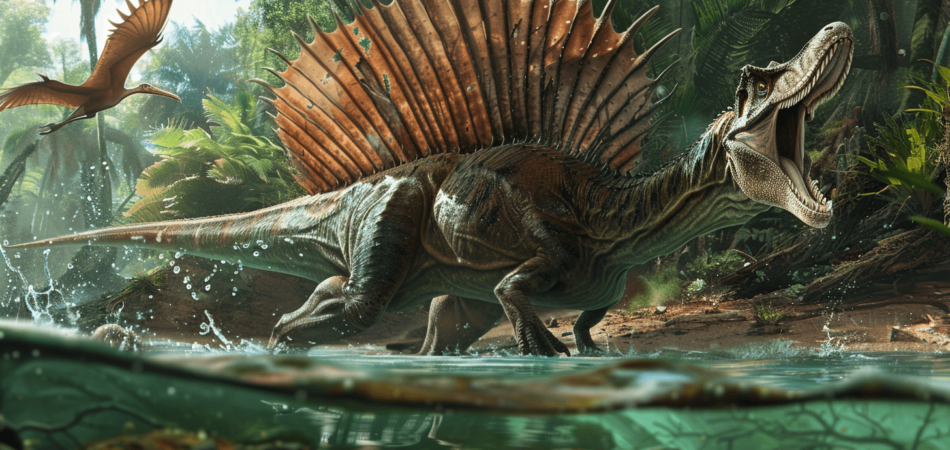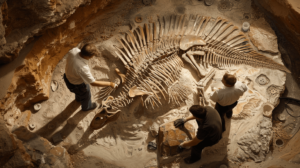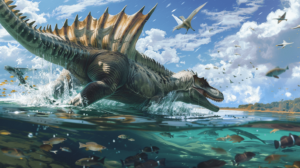Aardonyx Guide:
Aardonyx was an early dinosaur that lived in South Africa about 200 million years ago.
Aardonyx was an early dinosaur that lived in South Africa about 200 million years ago.

In the prehistoric popularity contest, Spinosaurus doesn’t just win; it towers over its competition, quite literally. This dinosaur, a behemoth of the Cretaceous period, has puzzled scientists and enthusiasts alike with its unique blend of features suggesting a semi-aquatic lifestyle. Unlike its purely land-loving peers, Spinosaurus navigated ancient rivers with a grace that belies its massive size, thanks to adaptations like a paddle-like tail and webbed feet. Yet, it’s the sail-like structure on its back that truly sets it apart, sparking debates and theories about its purpose. As we inch closer to unraveling this mystery, one cannot help but wonder what other secrets Spinosaurus is hiding beneath its colossal spines.

Unearthing Spinosaurus in 1912, Richard Markgraf made a groundbreaking discovery in Egypt that redefined our understanding of prehistoric life. His find, in the Bahariya Formation, brought to light an array of fossils that had been hidden for millions of years. These remains, which included jaw bones, vertebrae, ribs, and gastralia, were later studied and described by the German palaeontologist Ernst Stromer, who recognized their significance in the broader context of dinosaur evolution. Stromer, intrigued by the unique features of the fossils, went on to name the species Spinosaurus aegyptiacus in 1915, translating to ‘Egyptian spine lizard.’ This name highlighted one of its most distinctive features, which would only be the start of the fascination with this giant predator. The holotype, designated as BSP 1912 VIII 19, became a cornerstone for future studies on this species. Additionally, a second species, Spinosaurus maroccanus, was identified, underscoring the diversity within this genus. The discovery by Markgraf and the subsequent work by Stromer painted a vivid picture of a creature unlike any other known at the time. Their efforts laid the groundwork for understanding not only the physical characteristics of Spinosaurus but also its ecological role. However, tragedy struck during World War II when the original remains were destroyed, leaving the scientific community with a significant loss. Despite this setback, the legacy of Spinosaurus continued to grow. New finds in the early 21st century, including additional material designated as Spinosaurus B, have reignited interest and research into this fascinating dinosaur, ensuring its place as a key figure in the story of life on Earth.

Spinosaurus often stands out in the prehistoric crowd due to its distinctive sail and unique adaptations for an aquatic lifestyle. Unlike most other dinosaurs, Spinosaurus shared its environment with prehistoric aquatic reptiles and had to sail a world filled with fierce habitat interactions, including encounters with the giant crocodile Sarcosuchus. Its physical attributes and skeletal adaptations suggest a life spent in close connection with water. To create an imagery of Spinosaurus’s unique appearance:
These features not only highlight Spinosaurus’s unique appearance but also underscore its ability to thrive in a challenging environment filled with formidable creatures like Sarcosuchus.
Delving into its diet, Spinosaurus primarily preyed on fish, as suggested by the unique structure of its jaw and teeth. The formidable dinosaur, recognized for its massive size and distinct sail, showcased adaptations that facilitated its piscivorous lifestyle. The specific shape of its jaws and the presence of a distinctive notch near the jawline weren’t mere coincidences but strategic adaptations for capturing slippery aquatic prey. This feature allowed Spinosaurus to effectively trap fish, indicating a diet heavily reliant on these aquatic creatures. Further insights into the Spinosaurus diet come from the analysis of its teeth enamel. The teeth weren’t only sharp but coated in a special enamel suited for piercing and holding onto fish. This detail reinforces the hypothesis that Spinosaurus was a specialized piscivore, honing its skills in fish consumption. The dinosaur’s feeding habits were thus finely tuned to its semi-aquatic environment, making it a formidable predator of the ancient rivers it inhabited. Evidence suggests that Spinosaurus might’ve expanded its diet beyond fish, occasionally preying on other dinosaurs. This flexibility in diet indicates that while fish were the primary source of sustenance, Spinosaurus was likely opportunistic, taking advantage of other available food sources. Such adaptability in its feeding habits underscored the dinosaur’s dominance in its ecosystem, showcasing a versatile approach to consumption that went beyond mere piscivory.

Adapting to life both in and out of water, Spinosaurus exhibits unique locomotive features that support its semi-aquatic lifestyle. This dinosaur’s anatomy showcases a blend of terrestrial and aquatic adaptations, painting a vivid picture of its existence millions of years ago. Spinosaurus locomotion and posture were greatly influenced by its adaptations for water. Unlike its terrestrial counterparts, Spinosaurus was an efficient swimmer, thanks to several unique aquatic features:
These features underscore the Spinosaurus’s role as a semi-aquatic predator, adept at both swimming in search of prey and exploring the rivers that once flowed through the ancient landscapes. Its aquatic lifestyle is further evidenced by the anatomy adapted for an aquatic environment, setting it apart from other dinosaurs.

After exploring its unique locomotive features, it’s worth examining the purpose of Spinosaurus’ distinctive sail, which has intrigued scientists and enthusiasts alike. This sail, rising dramatically from the dinosaur’s back, was supported by long, thin neural spines, some reaching up to six feet. Unlike anything seen on other prehistoric marine reptiles, this feature sets Spinosaurus apart, enveloping it in a shroud of paleontological mystery.
The sail’s function has been the subject of much speculation. Its bone scaffold suggests it played a significant role beyond mere skin decoration, hinting at deep evolutionary purpose. One theory posits that the sail could have been used for social displays, helping Spinosaurus communicate with or intimidate others of its kind. Such displays could have been important in establishing dominance or attracting mates, not unlike the plumage of some modern birds.
Moreover, the sail may have had practical uses in body temperature regulation. Its large surface area could have helped absorb sunlight, warming the dinosaur in its aquatic habitat, or dissipate heat during hotter periods. This dual functionality would have been especially advantageous for a creature splitting its time between water and land.
Another intriguing possibility is that the sail aided in propulsion through water. The unique formation could have cut through water, helping Spinosaurus navigate rivers and lakes in pursuit of prey, adding an intimidating appearance to an already formidable predator.
Despite these theories, the true purpose of Spinosaurus’ sail remains an enchanting enigma. Its existence underscores the complexity and diversity of dinosaur life, leaving much for modern science to uncover.

Spinosaurus, often overshadowed by the famous T. Rex, actually boasted a larger size and unique adaptations that set it apart from its terrestrial counterpart. Unlike the T. Rex, which roamed the land as one of the most feared predators, Spinosaurus blurred the lines between land and water, embodying characteristics of both marine reptiles dinosaurs and traditional terrestrial dinosaurs.
The distinguishing features between these two colossal creatures include:
These distinctions highlight the Spinosaurus as not just one of the underwater dinosaurs but as the largest ocean dinosaur known, showcasing a fascinating blend of traits seen in both marine dinosaurs and the traditional, fearsome predators of the land. The discovery of underwater dinosaur fossils of Spinosaurus has provided invaluable insights into the diversity of dinosaur life, revealing the existence of complex ecosystems where aquatic dinosaurs thrived.

Several anatomical adaptations in the Spinosaurus, such as its high nostril placement and specialized tail, provide compelling evidence of its aquatic lifestyle. These unique features distinguish it as the first aquatic dinosaur, showcasing adaptations that enabled it to thrive in aquatic environments. The dinosaur’s nostrils positioned well back on the skull allowed it to breathe while partially submerged, a clear indication of a semiaquatic lifestyle tailored to an aquatic environment.
The specialized tail structure of Spinosaurus is another pivotal adaptation that supports the theory of its aquatic lifestyle. Unlike other dinosaurs, its tail was likely used as a propulsive organ in water, aiding in swimming and maneuvering through its aquatic habitat. This feature, along with other anatomical adaptations, paints a picture of Spinosaurus as a formidable predator not just on land but in water as well.
| Feature | Adaptation Significance |
|---|---|
| High nostril placement | Allows breathing when partially submerged, indicating semiaquatic habits |
| Specialized tail structure | Tail likely acted as a propulsive organ for swimming |
| Hind leg adaptations | Suggests adaptations for a semiaquatic lifestyle, aiding movement in water |
These adaptations collectively underscore the Spinosaurus’s unique niche as an aquatic predator, making it stand out among dinosaurs. Its ability to adapt to an aquatic lifestyle highlights the evolutionary flexibility and diversity among these ancient creatures, with Spinosaurus leading as a prime example of dinosaur adaptation for swimming. This evidence firmly establishes Spinosaurus’s position as not only a remarkable dinosaur but also as a milestone in our understanding of dinosaur evolution towards aquatic life.
During the Late Cretaceous Period, between 99 and 93.5 million years ago, Spinosaurus thrived in North Africa’s tidal flats and mangrove forests. This period harbored a unique and challenging environment that shaped the evolutionary path of Spinosaurus, distinguishing it from other dinosaurs of its era. Its adaptations for an aquatic lifestyle, including a wide, paddle-like tail, underscore its prominence as a semi-aquatic predator, adept at hunting fish and exploring the diverse ecosystems of its habitat.
The paleoenvironmental context of Spinosaurus reveals a landscape marked by:
Spinosaurus’s unique physical characteristics, such as its remarkable sail and aquatic adaptations, indicate a life spent mainly in the water. However, environmental pressures like droughts might’ve forced it to adapt as a land predator, showcasing its versatility in surviving and thriving in the changing landscapes of North Africa during the Cretaceous Period. Its existence in such a varied and dynamic environment underscores the complexity of dinosaur ecosystems and the evolutionary marvel that’s Spinosaurus, a creature perfectly adapted to its surroundings, yet capable of overcoming the challenges posed by its diverse and changing world.
Moving beyond its prehistoric existence, Spinosaurus has captured the public’s imagination through its dramatic portrayal in ‘Jurassic Park III’ and other media. This iconic dinosaur, known for its unique sail and status as a powerful predator, has become a staple in popular culture, fascinating dinosaur enthusiasts and the general public alike. Its depiction as a formidable antagonist in ‘Jurassic Park III’, especially its victory over the Tyrannosaurus rex, sparked wide discussions and cemented its place in the hearts of dinosaur fans.
Spinosaurus’s distinctive features, including its aquatic adaptations and impressive size, have made it a subject of interest not just in films but across various platforms. Video games, documentaries, and children’s books frequently feature this prehistoric giant, offering a glimpse into its might and lifestyle. These portrayals contribute to a broader understanding and appreciation of Spinosaurus, despite the debates surrounding its representation.
To illustrate Spinosaurus’s impact on popular culture, consider the following table:
| Medium | Impact on Popularity |
|---|---|
| Jurassic Park III | Catapulted Spinosaurus into the spotlight as a powerful antagonist |
| Video Games | Engaged audiences in interactive experiences, enhancing its iconic status |
| Documentaries | Educated the public on its unique characteristics and speculated lifestyle |
| Children’s Books | Introduced Spinosaurus to younger generations, fostering early interest |
Through these mediums, Spinosaurus not only entertains but also educates, leaving an enduring mark on popular culture as a sign of its lasting appeal.
Recent research has disclosed that Spinosaurus possessed webbed feet, further supporting its adaptation to a life spent mostly in water. This discovery adds to a growing body of fossil evidence that firmly places Spinosaurus as the most aquatic of all known dinosaurs. Scientists studying the remains of this colossal predator have pieced together a picture of a semiaquatic dinosaur uniquely equipped for life in and around water bodies.
The recent discoveries and research surrounding Spinosaurus paint a vivid image of its aquatic lifestyle:
These recent discoveries underscore the unique place Spinosaurus holds as a semiaquatic dinosaur, challenging previous assumptions and enriching our understanding of dinosaur ecology. By examining the diet and physical adaptations of Spinosaurus, researchers can draw intriguing comparisons with other predatory dinosaurs. For instance, studying allosaurus habitat and behavior provides valuable insights into the ecological niches occupied by different theropods, revealing how Spinosaurus may have coexisted with contemporaneous species in overlapping environments. Such investigations deepen our appreciation of the diverse adaptations that made these creatures successful in their respective ecosystems.
When it comes to the heavyweight champions of the dinosaur world, the debate over whether Spinosaurus was stronger than T-Rex is a hot potato. While both were formidable predators, Spinosaurus’s unique adaptations for a semi-aquatic lifestyle, including its swimming capabilities and the distinctive sail on its back, suggest it had a different set of strengths.
It wasn’t necessarily about brute force but rather how these giants adapted to their environments to thrive.
The rarity of certain dinosaurs stems from a mix of factors, including limited fossil finds, historical events, and unique environmental choices.
For one notable dinosaur, its scarcity is amplified by the destruction of vital fossils during a global conflict and its specialized aquatic lifestyle, which likely limited its fossilization opportunities.
This dinosaur’s adaptation to life partly in water and distinctive features, like a sail-like structure on its back, further complicate its study and categorization.
Is it possible that this prehistoric giant feasted on more than just fish? Yes, evidence suggests its diet wasn’t limited to aquatic prey. It likely consumed other dinosaurs, leveraging its jaw shape and hunting strategies.
Studies on tooth wear and fossils with teeth embedded in pterosaur bones indicate a varied diet. While fish were a primary source of nourishment, adaptations and behaviors point to a broader dietary spectrum, including terrestrial animals.
When comparing the ages of T-Rex and another dinosaur, it’s clear that T-Rex came later. This other dinosaur lived during the Late Cretaceous Period, about 99 to 93.5 million years ago, predating the T-Rex, which roamed the earth around 68 to 66 million years ago.
They didn’t share the same era, with a significant temporal gap separating them. This places the earlier dinosaur as an older species in the evolutionary timeline than T-Rex.